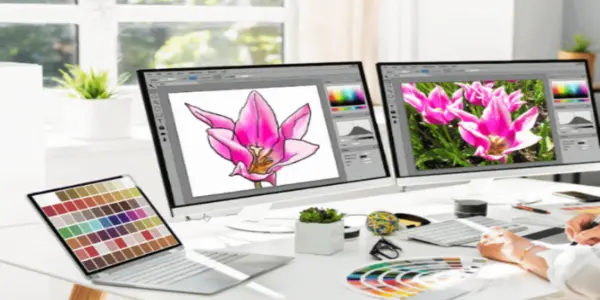Do you want to make A Career in Graphic Designing? Before we explain, let’s talk about what is a graphic designer. It is important to know about graphic design before the thought of beginning a career in graphic designing. A graphic design is an art of portraying thought, experiences and practice of planning through textual and visual content. Graphic design is a medium for communicating messages or ideas visually. So, in today’s blog we we’ll explore about career in graphic designing in detail.
Contents
What is a Graphic Designer?

Graphic designers are visual storytellers. They use images, shapes, and colours to create designs for websites, advertisements, and more. Their goal is to grab attention and communicate ideas clearly. They work closely with clients to understand their needs and create designs that meet their goals.
Here are some of the things graphic designers can do:
- Design logos, packaging, and other branding materials
- Create layouts for websites and magazines
- Develop user interfaces for apps and software
- Design marketing materials like brochures and posters
If you enjoy being creative and have a knack for visual communication, then graphic design might be the right career for you!
Also read: Top 10 Interview Questions For Graphic Designing Job
Job Responsibilities of Graphic Designer
A graphic designer’s job involves a creative process:
- Brainstorming ideas: They start by sketching out initial concepts, either by hand or using design software like Adobe Illustrator or Canva.
- Bringing ideas to life: Once they have a rough plan, they use various tools and technology to create visual elements that communicate a message, often using photos and artwork.
- Meeting client needs: Their specific tasks depend on the client’s requirements, but they may create marketing materials, design brochures and reports, develop print advertisements, enhance photos for digital displays, and much more.
Skills Required career in graphic designing

A graphic designer plays a crucial role in bringing visual concepts to life. Beyond mastering design software, they wear several hats to ensure successful projects.
- Client Collaboration:
- Meeting with clients to understand their needs and project scope.
- Advising clients on audience-specific strategies and messaging.
- Creative Execution:
- Designing visuals that effectively communicate a message or brand identity.
- Developing various graphic elements like illustrations, logos, and website graphics.
- Selecting the perfect combination of colours, images, text styles, and layout.
- Presentation and Refinement:
- Presenting design concepts to clients or art directors.
- Incorporating client feedback into the final design.
- Reviewing and finalizing designs to ensure accuracy and quality.
Why Graphic is the Best Career Choice?
Here are some of the reasons why you might consider a career in graphic design:
- Promising job market: The field of graphic design is expected to grow by 20%, creating a significant number of job opportunities.
- Competitive salaries: Depending on your experience level, you can expect to earn a good salary. Beginners can expect to earn around Rs. 2-3 LPA, while experienced professionals can earn Rs. 5-10 LPA.
- Work with top companies: Many well-known companies, such as Google, Facebook, and Microsoft, hire graphic designers, offering the chance to collaborate on exciting projects.
- Freelancing opportunities: If you enjoy flexibility and being your own boss, you can earn extra income by taking on freelance graphic design work.
- Continuous learning: The field of graphic design is constantly evolving, so you’ll always have the opportunity to learn new skills and stay up-to-date with the latest industry standard software.
Also read: What is Graphic Designing | Career in Graphic Designing
Required Qualification Needed for Career in Graphic Designing
- No specific educational requirement is mandatory: Individuals with a high school diploma (10+2) in any stream (Science, Commerce, or Arts) can pursue graphic design courses and enter the field.
- Certification courses: These are popular options for beginners to gain the necessary skills and knowledge to launch their careers. They can also demonstrate a commitment to professional standards and continuous learning, potentially increasing job opportunities.
- Entry-level positions: Individuals with no prior experience or certification may start in junior, internship, or apprenticeship roles before transitioning to graphic designer positions.
- Bachelor’s degree: While not mandatory, a bachelor’s degree in graphic design, fine arts, or a related field is generally preferred for both entry-level and advanced graphic design positions. This can give candidates an edge in the job market.
How to start your career in Graphic designing?
Whether you’re new to the field or looking to make a career change, here’s a roadmap to guide you on your graphic design journey, tailored to your current experience level:
No Prior Knowledge:
- Build your foundation: Enroll in basic art and design courses to develop your artistic skills and improve your sketching abilities.
- Showcase your talent: Create a professional portfolio that demonstrates your unique style and abilities.
- Master the tools: Consider pursuing a certification in graphic design software to solidify your technical skills.
Basic Knowledge:
- Deepen your understanding: Take a comprehensive graphic design course to grasp the core principles of the field.
- Software proficiency: Master industry-standard programs like Adobe Creative Suite (Illustrator, InDesign, Photoshop) and others.
- Stay informed: Follow popular design websites and forums to stay updated on trends and network with the community.
- Refine your craft: Learn typography and practice creating effective layouts.
Intermediate Knowledge:
- Expand your expertise: Gain knowledge about visual identity systems, branding touchpoints, and brand architecture.
- Sharpen your tools: Explore advanced features and techniques within your chosen design software.
- Seek inspiration: Learn from established designers and their creative approaches.
- Teamwork makes the dream work: Develop the ability to collaborate effectively with diverse teams, including copywriters, photographers, and marketing professionals.
- Communication is key: Hone your communication and client management skills to build strong relationships and manage projects efficiently.
- Stay ahead of the curve: Continuously learn and adapt by keeping up with the latest design trends, technologies, and techniques.
Advanced Knowledge:
- Specialize and advance: Consider pursuing further education in specific areas like desktop publishing, 3D design, web graphics, or animation.
- Market mastery: Learn to conduct market research and analyze competition to inform your design decisions.
- Leadership potential: Develop project and people management skills to lead and inspire your team.
Also read: 5 Best Graphic Designing Software for Students in 2023
Top Companies that hire Graphic designers

These are top companies that hire graphic designers
- Accenture
- IBM India
- Dell International
- Capgemini
- Quest Global
- Indecomm Technology
- Leo Burnett
- UnitedHealth Group
- Cognizant Technology
- Info Edge
Also check:
-
5 Best Computer Course in India for Private Job (India में प्राइवेट नौकरी के लिए 05 BEST कंप्यूटर कोर्स)
-
Google jobs in India | Google में चाहिए नौकरी तो कर ये 5 कोर्स - मिलेगा लाखों का पैकेज | Google Jobs
-
Retail Management Career | Retail Jobs | How to get Retail Management Job
-
How to Start Earning as a Graphic Designer?
-
Paramedical Courses | Paramedical Career | कम बजटऔर कम फीस में मेडिकल करियर बनेगा
What is Salary prospect for Graphic designer?

In India, graphic designers can expect to make anywhere from 1.1 lakhs to 6.5 lakhs rupees annually, with the average being around 3 lakhs. While creativity is definitely a key part of success in this field, getting a certification can open doors to better jobs and potentially boost your earning power in the long run.
Also check:
Conclusion
A career in graphic design offers a unique blend of creativity, challenge, and opportunity. Whether you dream of crafting visually stunning brand identities, designing user-friendly interfaces, or bringing ideas to life through captivating illustrations, graphic design has a path for you. With a strong foundation in design principles, the dedication to hone your skills, and the drive to stay updated with the ever-evolving industry, you can embark on a fulfilling journey of turning your creative vision into reality. Remember, the most successful designers are lifelong learners, constantly seeking inspiration and pushing their creative boundaries
You can do the diploma course in graphic designing from our DOTNET Institute, we provide both online and offline courses at affordable prices. This diploma course has 12 Modules with a duration of 6 months.
FAQs
Graphic designers create visual concepts using various media and software to communicate ideas. They work on projects like logos, brochures, websites, packaging, and marketing materials.
Creativity, strong visual sense, good communication and collaboration skills, proficiency in design software (like Adobe Photoshop, Illustrator, InDesign), and knowledge of design principles are essential.
While a formal education is not always mandatory, a bachelor’s degree in graphic design, art, or a related field can be beneficial. Many designers also learn through online courses, bootcamps, or personal projects.
Graphic design is a growing field with various career paths, offering flexibility and opportunities to work in diverse industries. However, it can be competitive, and freelance work might require self-discipline and business acumen.
Build a strong portfolio showcasing your skills and creativity. Look for internship or volunteer opportunities to gain experience. Network with other designers, and continue learning through online resources and attending workshops.


